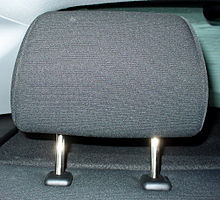headrest


Headrests in vehicles are used to reduce the effects of forces on the cervical spine in the event of sudden changes in vehicle movement. In particular, they protect the occupants in the event of an accident .
The extremely increasing traffic density in the 1960s due to growing prosperity led to an increasing number of accidents and injuries in road traffic . In this context, the automotive industry recognized an increased need for innovation in automotive engineering to avoid injuries in the event of an accident. In addition to seat belts , headrests were also widely used in new automobiles.
history
The first known patent for a headrest (headrest) in the car was the American Benjamin Katz issued 1,921th Further patents followed in the 1930s and 1950s. Most of the headrests of that time were not integrated into the seat, but rather attached to the backrest with a large cuff. Some models are also lashed to the side of the backrest. The suppliers of automotive accessories had to adjust their neck rests to every new automobile coming onto the market. Immediately after the appearance of the NSU Prinz Type 110 at the beginning of 1966, the largest English company for car accessories, Karobes , supplied the exactly matching neck support, "which is attached without a screw and can be tilted forwards and backwards." On January 1st, 1969 Neck rests became compulsory for new US cars, followed by Asian and European car manufacturers in the 1970s.
In Germany, Karl Meier was the pioneer in the field of headrests. In 1952 he founded the Kamei company , derived from KA rl MEI er. Meier had already dealt with the production of various accessories for the interior of the VW Beetle and, among other things, invented the so-called "slumber roll". This was criticized for promoting driver fatigue. Meier argued, however, that relaxed driving promotes concentration and also protects the driver's neck. Karl Meier pursued this safety aspect further and shortly afterwards presented the first safety head restraints.
Mode of action
When strong deceleration of the car - with full braking or the collision of the vehicle with an obstacle - fast, the head of the vehicle occupants due to the law of inertia , first forward and then snaps back again at the moment of complete vehicle standstill. Without a headrest, the cervical vertebrae would be overstretched backwards beyond their load limit. Severe traumatic brain injury or nerve crushing may occur.
The headrest prevents overstretching of the cervical spine, especially in the event of a rear impact.
Adjustment
The headrests, which can be manually or electrically adjusted in height or inclination, should be adjusted so that the top edge of the headrest is at the top of the head (of the head); the back of the head is a few centimeters away from the headrest. Only in this way can the headrest function fully in an emergency. However, the headrest is only suitable as a support in the literal sense of the word in an emergency. During normal driving, it should not touch the head so as not to restrict mobility. Supporting the head should also induce an excessive relaxation posture at the expense of alertness.
Legal regulation
In Germany, according to the road traffic licensing regulations , headrests are required on the front outer seats for vehicles up to 3.5 t in accordance with Section 35a (2):
- (2) Passenger cars, buses and coaches and motor vehicles intended for the transport of goods with a maximum speed of more than 25 km / h determined by their design must have seat anchors, seats and, if their maximum permissible mass does not exceed 3, 5 t, the front outer seats must also be equipped with headrests.
Active headrest
Today the headrests in many automobiles are part of the passive safety system. Some headrests, so-called active headrests, lean forward in the event of an impact in order to be able to catch the head for valuable milliseconds (see WHIPS ). This prevents the so-called "whiplash effect", an S-shaped hyperextension of the spine. This is triggered by the inertial forces of the occupant when a vehicle drives up from behind. With active headrests, a lever system is integrated in the seat back, which folds the headrest forward. More and more car manufacturers are equipping their vehicles from the compact class with active headrests, for example Honda and Hyundai . In the future, some active headrests will also include airbag systems.
variants
In the mid-80s, open, so-called frame headrests, which allow a little more rearward visibility, came onto the market in the middle.
The front head restraints can also be part of the multimedia system in the car and be equipped with screens for the passengers in the rear.
literature
- Hans-Hermann Braess, Ulrich Seiffert: Vieweg manual automotive technology. 2nd edition, Friedrich Vieweg & Sohn Verlagsgesellschaft mbH, Braunschweig / Wiesbaden, 2001, ISBN 3-528-13114-4
See also
Web links
- http://www.oeamtc.at/netautor/pages/resshp/anwendg/1109047.html Council of the Austrian Automobile Club
- http://www.versicherung-und-verkehr.de/index.php/1.0.448;cmid;6;crid;27 Council of the General Association of the German Insurance Industry eV
Individual evidence
- ↑ US Patent 1471168: Headrest for Automobile Seats and the Like
- ↑ Karobes in the English Wikipedia
- ^ Dudley Noble: A New and Larger NSU Model . Financial Times London, February 26, 1966

